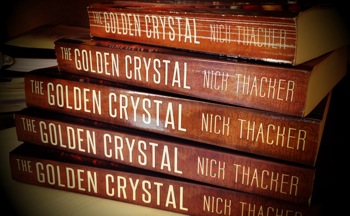
I’ve been going around and around with numerous book printers over the past three years. Ever since I got the crazy, half-baked idea in my head that I wanted the “control, speed, and cost-effectiveness of self-publishing” rather than the traditional way to do it, I’ve been through the ringer with pretty much all of the well-known “indie”-book creation shops.
Specifically, I’ve been down into the depths of customer service, user forums, technical spec sheets, and more with the top three: Lightning Source International, Lulu, and CreateSpace.
What do I have to show for it all?
Well, in case you weren’t aware, I have a professionally-designed, well-produced and edited version of my first novel, The Golden Crystal, available on Amazon, complete with print copy, Kindle version, and an audiobook edition (on the way!) produced through Audiobook Creation Exchange (ACX.com).
But the point of this post isn’t to talk about this total process — it’s to talk about one specific aspect of the book-to-market journey: where to print (produce) your masterpiece.
What is the best option for beginner, intermediate, and veteran self-publishers? Is it the same place for each of these skill levels? What option produces the best quality books with the most control over the process?
And, perhaps most importantly to some, which option is cheapest?
This is the post I’ve wanted to write for a long time, and one that I wished was written before I got started! Ready? Dig in!
The rules
Here’s how it will work: I’ll introduce the companies — I’m reviewing three — and then I’ll break down my experience with each through a few different criteria:
- Ease-of-use. This criterion will refer to how the overall process — from conception, through the upload/customization process, to the finished proofing and shipping — went at each firm. It will be a comment on the respective technical requirements, time needed, and more.
- Price. This criterion is pretty straightforward — how much did the process cost, specifically in terms of dollar amount (rather than ROIT or Return on Invested Time, which is sort of covered in the “Ease-of-Use” section)?
- Quality. What did the final product look, feel, and seem like? Could you tell it wasn’t printed “the real way,” as my mom would put it?
For the sake of simplicity, or if you’re just here to get the bottom line for each option, I’ll go ahead and do an “overall score” thingy, from 1 to 10, with 1 being “Wow, I can’t even believe this crappy excuse for a company even made the list,” and 10 being “Holy book-printing, Batman, we’ve found our supplier!” (Or something like that — you choose)
Here we go:
Introducing LSI
Lightning Source International is owned by Ingram, one of the largest book companies in the world, and LSI happens to be the printer of most of the material you’ll find a bookstore at least here in the States. All of this means that they’re owned and operated by a company that’s been in the book business a long time, for whatever that’s worth.
While they used to apparently only print for publishing houses in bulk, LSI recently added a POD (print on demand) option for small fries like me (or maybe to just make more money…).
Introducing Lulu
Lulu is based in Raleigh, NC, USA, but has been growing steadily for the past few years, with numerous thousands of books being added to their catalog each month. They are focused on providing a POD service to the end-user-as-author, which is my fancy way of saying that they’re mainly trying to capture the market of freshly-minted authors who’d like a vanity copy or two for their coffee tables.
In recent years they’ve added different binding and cover options, as well as a growing list of size options for printed books, and they’re also one of the few services to provide a way to print hardcover books.
Introducing CreateSpace
There’s a good chance you’ve already heard of CreateSpace, the Amazon giant’s own POD arm in the self-publishing world. Purchased by the bookseller giant in 2005, CreateSpace was founded in 2002 as CustomFix, a POD DVD service, and has since expanded to include options for print-on-demand books and CDs.
They are the exclusive recommendation from Amazon when it comes to servicing POD books, and there’s a strong chance that if you’ve purchased a self-published book from Amazon in the last 5-10 years, it’s come from CreateSpace.
The Bottom Line(s): Comparing and Measuring the Self-Publishing Print Services
With the fancy introductions out of the way, let’s jump now to the main show: comparing, contrasting, and measuring each of these venerable and useful services so we can get to the bottom line.
Metric #1: Ease-of-use
I found that both CreateSpace and Lulu had great, navigable, and user-friendly systems, with CreateSpace barely edging out Lulu. CreateSpace has both a “Guided” step-by-step process, very similar to Lulu’s, and also an “Expert” streamlined, single-page GUI for faster upload, prep, and submission. I’ve used all three, and I like CreateSpace’s Expert process, but I like the CreateSpace “big, giant, button” version when I’m comparing the two Guided processes.
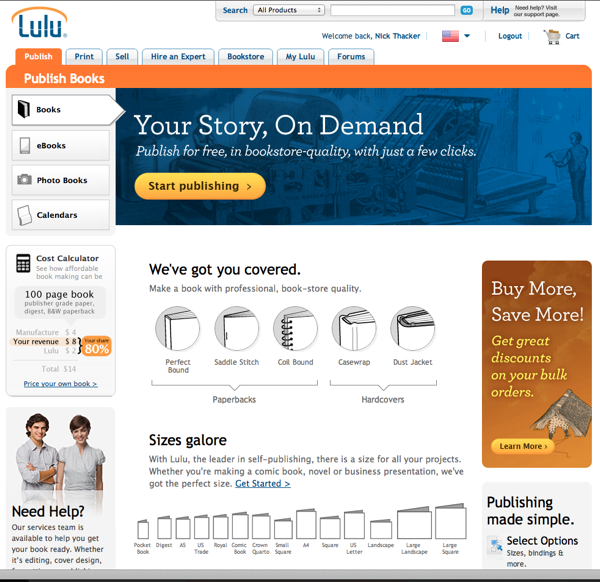
However, I have to give credit to CreateSpace for going the extra mile to make things dead-simple: an extra point to them for offering two processes.

And yes, there’s a reason I didn’t really include LSI when it came to discussing the “online submission process” — LSI might as well not have one. Seriously, guys, come on: have any of you ever even used the Internet? The process, when not too archaic to even use is frustratingly difficult to navigate (don’t even get me started — have you tried setting up a new project? You have to create a “New Client” and go through that process first, which includes printing, signing, and faxing legal documents back and forth! Ugh.)
When you finally do get set up as a client (which is really just a publishing imprint, anyway), you then get assigned all of 4 representatives: a POD Client Services Rep, an eBook Client Services Rep, a Credit Representative, and a Sales Rep. Wow! My one book and I feel important!
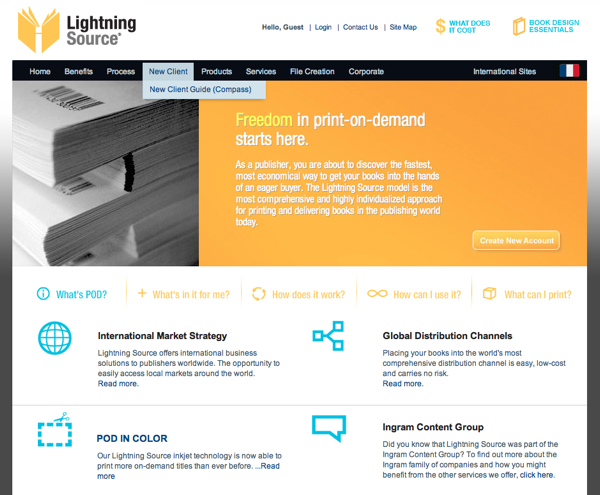
Anyway, going through their process isn’t impossible, it’s just close to the worst thing in the world. I had to go back and forth with the online FAQs for hours before I finally decided that yes, in fact, I have submitted my book successfully and one should magically show up in the mail in a few weeks. Further, it turns out that if you don’t have your book ready to go — and I mean ready to go — you shouldn’t bother uploading it: you’ll just wait around for a few days (which is eons in this world, folks!) to hear something like, “your cover features transparent images,” or “images inside your book are showing up at too low resolution,”* both of which are cryptic (I didn’t use any transparent images on my cover, and the interior images were created at 300 dpi) and almost totally unmentioned in their FAQ section or elsewhere online.**
*This stuff is exactly why I didn’t end up using IngramSpark, the pseudo-Lightning Source company that’s apparently going to take the self-published author and indie author world by storm. My take: they’ve got some serious work to do in getting their platform to work properly. I had a difficult time getting communication back from them, and had to eventually give up since I couldn’t get my book properly uploaded. That said, once they do get the kinks worked out, it’s way cheaper than their parent, LSI, to upload and revise books. Keep an eye on this company — they might be my go-to solution in the near future!
**By doing my own research into Adobe InDesign (the industry-standard professional layout tool I used to finalize my book’s cover and interior files), I found out that I can “Pre-Flight check” my files, telling me where exactly these demon image-spirits were showing up, and then how to fix them (apparently I enlarged the files at one point, bringing down the total output resolution to lower the LSI-required dpi). I got everything fixed, but my word — if I wasn’t a professional graphic designer and web guy in another life, with ready access to Adobe’s Creative Suite (Photoshop, InDesign, etc.) — I’d have been totally lost. I wasn’t lost at this point, but I was a little pissed — more on that later! ($$$)
So, bottom line: Lulu and CreateSpace both are easy to use online systems for uploading, choosing options, and finalizing your book projects, and both have active online communities, with CreateSpace clearly taking the cake here. I gave an extra point to CreateSpace for the interaction you’ll get online (I never went 24 hours without a user- or staff-response on the forum! Way to go!), and for offering me a no-BS one-page form for getting my book ready to go. LSI, you suck at all of these things. Please fix them.
Lulu: 7/10 CreateSpace: 8/10 LSI: 2/10Metric #2: Price
Okay, here’s the rub: if you’re here for price alone, you’re going to be happiest at CreateSpace. Lulu is close in price, but I wasn’t happy about the reduced royalties they give you by selling through Amazon (obviously these aren’t part of the deal with CreateSpace since they’re owned by Amazon), and the exorbitant rate they’ll charge your customers in order for you to get a reasonable royalty.
While both offer similar pricing structures, LSI is again out there on their own. When you upload a book to Lulu or CreateSpace, the price is… free. Only when a book is printed do you need to pay (and even then, you’re getting money from the customer who bought the book, and the only thing you’re paying for is the printing price or royalties in Lulu’s case). Yet when you upload a book to LSI, you’re paying… about $75.
Yeah, seriously. Below is a screenshot of my Accounts Receivable Invoices (Search & View) section (yeah, that’s the actual submenu item name — I wasn’t kidding about the stupid GUI, huh?) at LSI’s website, where I tried and eventually succeeded to upload the correct files and have my novel proof printed (note this is just the bottom three or so results — there were five total!):
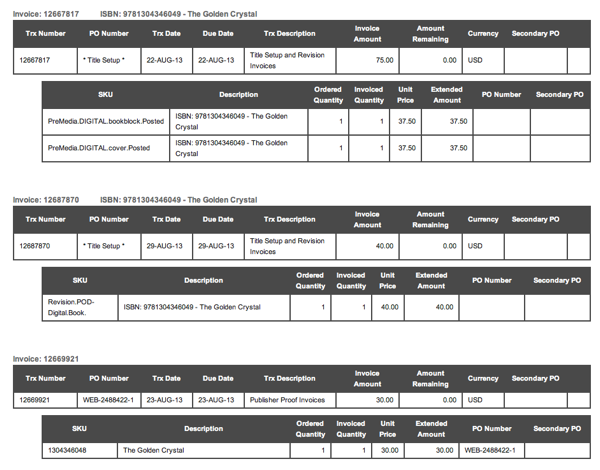
My best guess at deciphering this is:
- The top of the list shows my initial attempt at uploading the files — one for the cover, one for the interior PDF — and each was $37.50! I’ve seen coupons for this in the past, but alas, when I needed to move on it, there were none available.
- The middle item is my one revision (it was my fault) — I accidentally uploaded the wrong interior file. Instead of the 6″ x 9″ size, I uploaded the one I used for Lulu to print a mass-market size (around 5″ x 8″ or something…). Either way, mistakes cost dearly with this service, to the tune of $40 per revision!
- The bottom of the list is the invoice for the proof to be printed — I get to choose between Rush/Overnight and Rush/Overnight for $30 — yep, only one option!
- Shipping, freight, proof print, and handling fee (all itemized, though not included in the screenshot) was $21 total
- “Digital Catalog Fee – POD” was $12, and I’m not sure what this is, other than the fee they charge for the glory of being included in their amazing system… ?
As you can see, I’m going to need to push a lot of books to make up for the expenses here. The question is, was is worth it?
We’ll have to go into the Quality section to see… cliffhanger!
Lulu: 5/10 CreateSpace: 9/10 LSI: 3/10Metric #3: Quality
Since I forgot to mention it, I’ll talk a little about the different size and paper types that each service offers in addition to the overall quality. When printing a self-published book, there are a few considerations:
- For whom are you printing? Yourself? Your family/friends? The general public? Quality requirements can differ greatly if you’re going to keep a copy on your end table in the guest bedroom than if you’re going to expect someone to shell out hard-earned dough to buy a copy.
- What size should you print? Mass-market paperbacks “feel” better for many readers, as they’re smaller and easier to handle, but trade-sized hardcovers and paperbacks are more “professional,” and give that “I’m serious about this stuff” message.
- Are binding options important? If it’s a cookbook, workbook, or something similar, the book’s ability to lay flat on a surface might be a selling point. Otherwise, the traditional “perfect bound” book option is what you’re probably looking for. Saddle-stitch and other options are out there as well, but not as easy (or cheap) to find.
For my books, I wanted to find the three standards: Trade Paperback, Hardcover (also trade size; 6″ x 9″), and Mass-Market Paperback (~5″ x 8″). I wanted to test all three, but I knew that getting at least one option from each of the places that offered them would satiate this blog post, my curiosity, and hopefully those of you looking for the same information.
Here’s what I found:
Lulu and CreateSpace, again, clock in about the same as far as trim sizes are concerned. When navigating the depths of the offerings, I didn’t find very many sizes that I’d reasonably want to print on not offered, and the few that weren’t exactly the same from one shop to another were awfully close.
I found the standard size range at both to be similar, and I even found some of the European/UK standards available at both. Since I’ll mostly print “trade” sized books since I can use the same PDF files for hardcover and paperback, I didn’t worry too much about the obscure sizing options, but it might be a game-changer for you.
The biggest difference between the two shops’ product offerings was that Lulu prints hardcover books, and CreateSpace does not. To me this is a glaring omission on CreateSpace’s part, though I have to believe it’s a strategy to keep costs low.
That being said, here are a couple closeups of the hardcover book from Lulu:
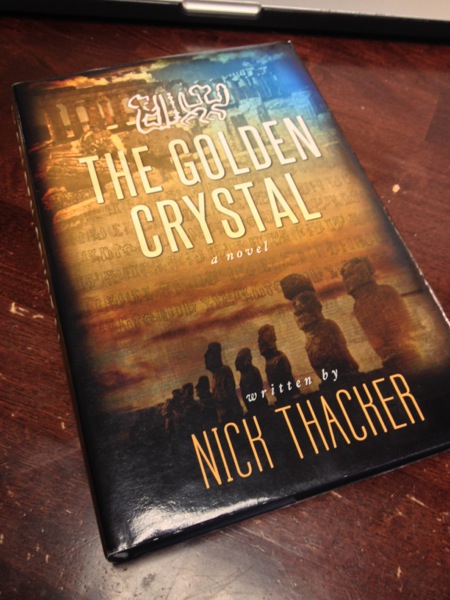
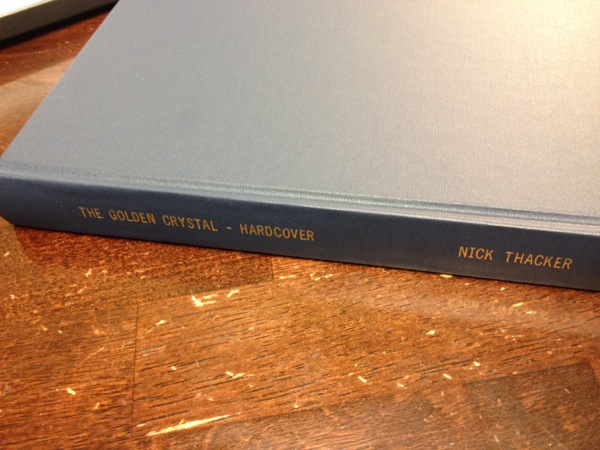
I was generally happy with it. My goal with The Golden Crystal was to produce a book that was indistinguishable from a “traditionally”-published one, and Lulu’s hardcover came close:
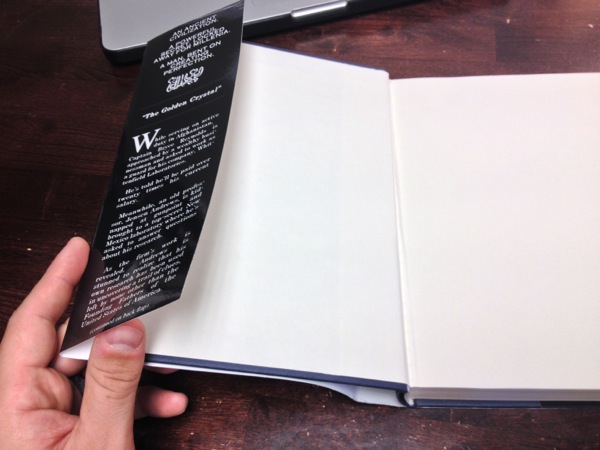
There are still some things I’d like to see from them, however:
- Overall, it “feels” lighter in my hands. Not sure why…
- The paper is a little “creamy.” I like cream-colored paper, but Lulu’s is just dark enough for me to question it.
- The case wrap is a shiny, glossy plastic-like paper, and I’d love some different options, though I’m splitting hairs at this point (hey, every great list has at least three items, right?)
Let’s take a look at the Lulu paperback version:
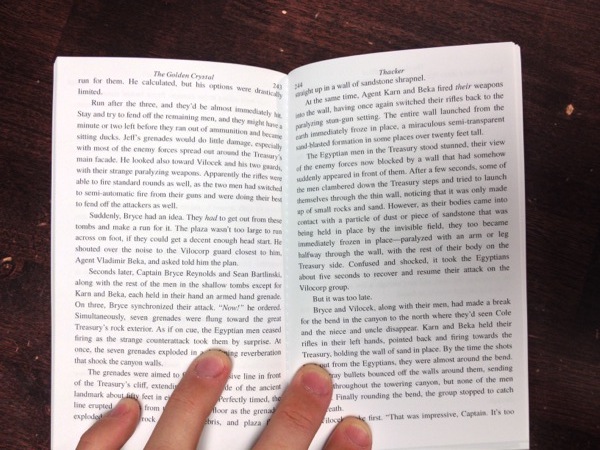

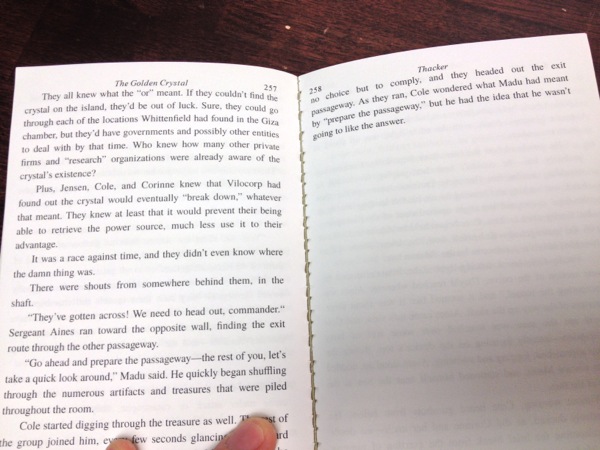
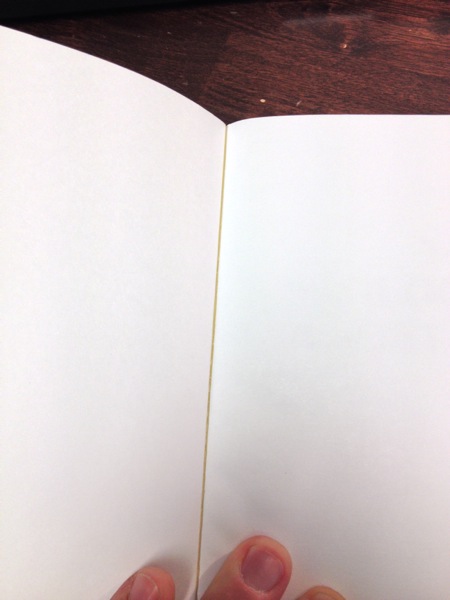
For these first proofs, I wanted a general hardcover trade-sized copy and a mass-market paperback. I ended up nailing the size, but Lulu was way off my expectations of quality for a few other reasons:
- The paper color (I chose white) was really white. I guess I should’ve known, but I was still taken aback by just how bright the paper was.
- Also, the paper’s thickness feels an awful lot like copy paper — the weight and brightness of it together seems like I could’ve printed my own at a copy shop and had it bound for the same effect.
- The glue, which I know has been mentioned online before, is pretty yellow — which doesn’t matter to me unless…
- …the binding cracks very easily, making the book overall feel sort of low-budget.
CreateSpace vs. Lulu for paperback
Since CreateSpace doesn’t do hardcover, and I was generally happy with the Lulu proof I got, I didn’t order one from LSI — in the future I certainly will, and I’d expect that LSI’s will only be better than what Lulu’s able to do.
Anyway, my next job was to compare the two front-runners in a growing market of quick POD book companies: Lulu and CreateSpace. You’ve already seen the Lulu pics, but here are a couple side-by-side and of a few different sizes:
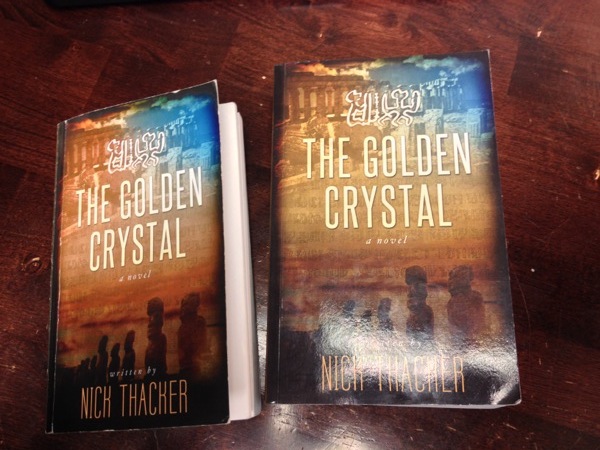
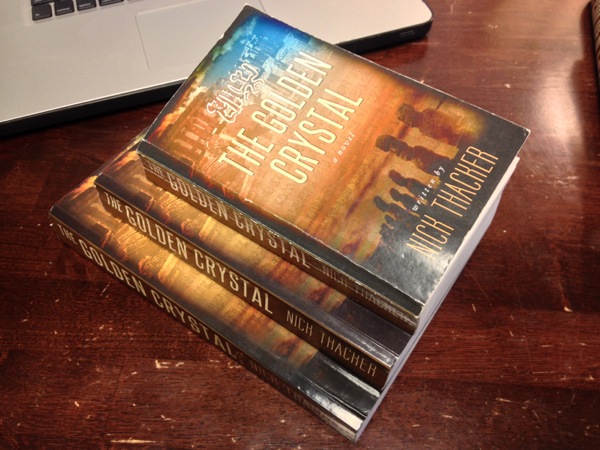
I found very few distinguishable differences between CreateSpace and Lulu’s paperback, regardless of size — both feature glossy covers, yellowish glue, cracky bindings (“perfect bound” in case you’re wondering what I chose), and very white paper.
I don’t have any images of CreateSpace’s cream-finish paper of The Golden Crystal because I’d already seen it when I made copies of my first nonfiction book, Welcome Home. I was, to say it bluntly, not satisfied. CreateSpace, it seems, offers you two options:
- Very bright white
- Very yellow-y cream
And that’s it. Who knows what the future will hold, but I didn’t want to settle for computer-paper quality books.*
*Okay, okay — I’ll admit it. Technically speaking, “computer/copy paper quality” is actually better than what most books are printed on, which is called “publisher grade,” “market grade,” or something else, depending on who you ask. However, I like my computer printouts to look and feel like computer printouts, and my books to look and feel like, well, books. Which means that I don’t care if this thicker, bolder stuff is “better” quality — it still feels fake when it’s printed into a book… hope that makes sense.
Testing paperbacks from LSI
On to the final step in the chain — Lightning Source International. I’d heard that people generally thought LSI was “better” than the aforementioned two printers, but I couldn’t seem to find any hard evidence or examples online anywhere.
However, I was intrigued by the myriad of options they offered: from many more sizes of paperbacks in different combinations of cover finish, paper type, paper color, and binding options, as well as being able to print hardcover and paperback, I knew I needed to test them out. Plus, they did the impossible: LSI offered matte cover as an option. No way.
I decided to upload and proof a standard size: 6″ x 9″ on the dot, industry-standard trade paperback, for two reasons:
- Since it was expensive to “test” the waters with LSI, at around $100 a pop, I wanted to receive something that I could really be proud of, sell, or give away if it was nice-looking.
- I already had the files done, minus the spine width for their slightly different paper thickness settings.*
*While I’m on the subject, all three of these printers (and IngramSpark included) offer book cover template generators, with LSI leading the charge with a generator that will automatically grab your ISBN number (assuming you’ve previously purchased one from Bowker and filled in the details) and then fill out the rest of the form automatically. Pretty cool, huh? Here are links to each generator: Lightning Source Cover Template Generator, Lulu.com Cover Template Generator (need to have an account), CreateSpace Cover Template Generator, and IngramSpark Cover Template Generator (need to have an account).
The results, if I do say so myself, were stunning. While it’s hard to capture the glossy-vs.-matte covers in images, you can see the difference a little in the picture with my lamp’s light reflection (in each, the CreateSpace version is on the left, and the LSI version is on the right):
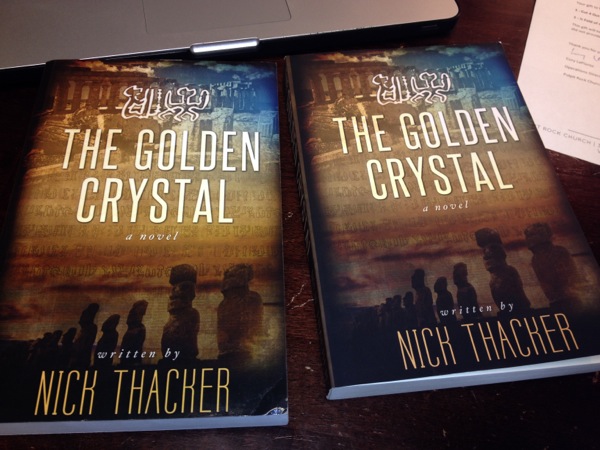
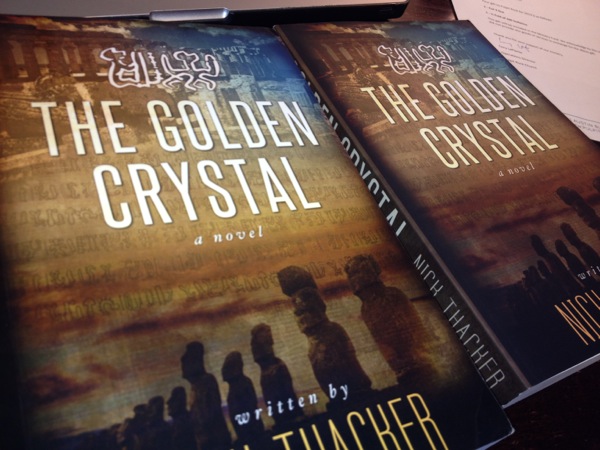
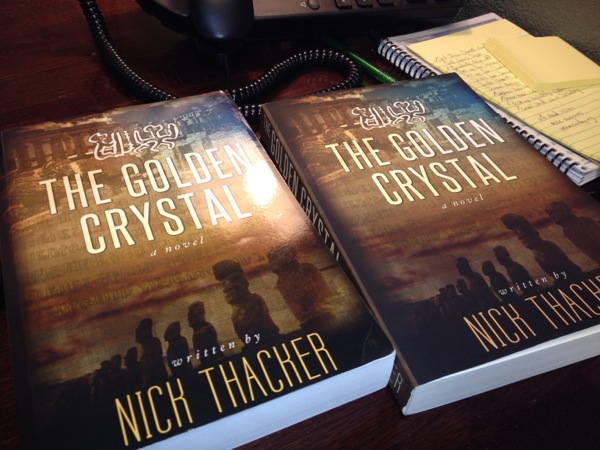
And here are some shots of the interiors, set to the same page (generally — remember, I was working from different size options here). Hardcover w/ cream paper from Lulu in the back, paperback w/ cream paper from LSI in the middle, and finally paperback w/ white paper from CreateSpace in the front. All are 6″ x 9″:
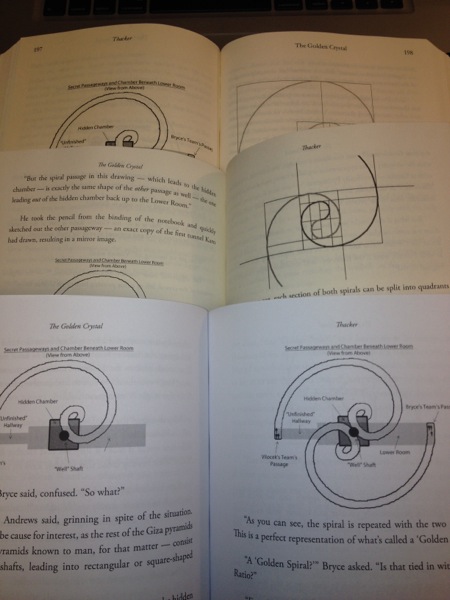
Flash on — in this version, notice the difference in paper thickness between the three. LSI looks the most “normal,” with almost-visible lines from the opposite side bleeding through on the right. I could live with Lulu’s paper, since the color is close, but the CreateSpace white stock is way too thick!
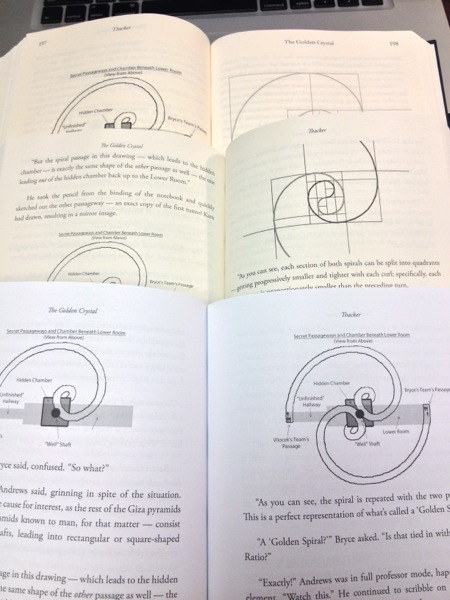
With this one, I’m not quite sure what causes the difference, but there’s a clear benefit to LSI’s binding:
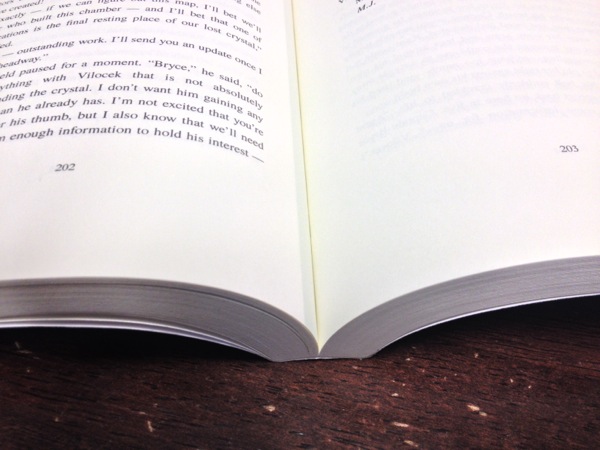
Over that of CreateSpace/Lulu:
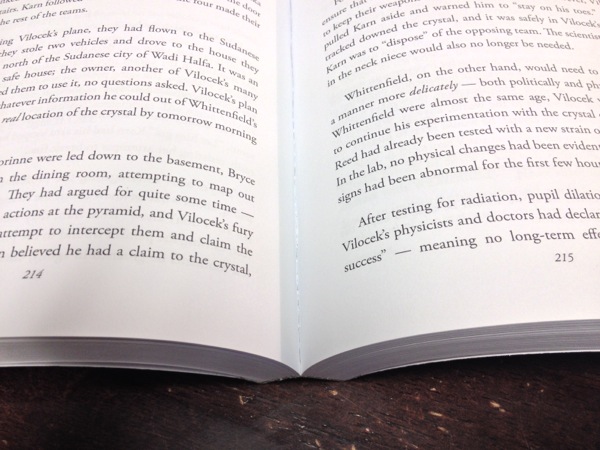
Finally — and this couldn’t be done with my photography equipment (iPhone 4s, in case you’re wondering!) — there’s a huge difference to me at least in the quality at which each book is printed. For example, both Lulu and CreateSpace use a type of digital printing that involves laser printing a series of dots at a certain DPI — say, for example, 200-300 DPI (dots per inch), whereas LSI uses a slightly different technology, though I think it’s still digital. Whatever the cause, I can actually see the little dots that make up each item — be it a letter or image — on the pages of a CreateSpace or Lulu book.
LSI’s inked items, however, when viewed super-closely, are actually thicker layers of ink, and there are no dots to be seen. The result is that reading a page of copy in an LSI-created book is considerably easier, in that it’s darker, stands out better on the page, and has that “professional” feel to it.
I know this last item, especially without pictures to back it up, is difficult to trust me on, but here’s the bottom line: LSI creates way better books than either of the two companies tested. Hands-down, no questions asked. If you’re after quality, and you don’t mind paying a premium for it, LSI is the way to go. For me, this was a game-changer. I’m serious about my finished product, and I really wanted to achieve something that’s indistinguishable from a “traditionally-published” book.
For me, there was no competition. LSI wins the quality game, and since I honestly can’t see the quality getting any closer to that of a “real” book, I give LSI a 10/10. The other two shops lost favor for me not just because of the low quality, but because when handling the finished products, I strongly believe anyone who’s handled a book before could tell that these weren’t “real.” Here are my ratings:
Lulu: 2/10 CreateSpace: 2/10 LSI: 10/10What does this all mean?
Well, for me, it means that I’m going to be very excited when/if IngramSpark gets off the ground and happens to print at the same standards as LSI, which I believe is very possible. It means that until then, I’m printing with LSI for my final proofs, but I’ll probably continue doing edits/test proofs through CreateSpace and Lulu, since they’re way cheaper.
If you’re interested in printing a book to have on hand as a vanity project, I’d recommend going hardback through Lulu — it’s the cheapest option for the high quality you’ll get.
If you want cheap copies of a book you’re not planning to do much with to hand out to friends, family, and acquaintances at work, or you aren’t much for technical stuff, go with CreateSpace — it’s easier to set up, work with, and use, and there’s a larger online audience of helpful people to guide you through the process.
I hope this review was helpful or at least insightful to you in some way — since the currency of the web is sharing and caring, would you mind sharing this post with your network and leaving a comment? Let me know if I’ve missed anything, and by all means let me know if your results differed!
Happy self-publishing!


Fantastic post, very informative, and your books look great. I’ve been having a look at the new Lightning Spark deal and wrote a post about it recently (http://bit.ly/1eCQtrm). I’ve had books printed by Createspace and they were OK but I share your misgivings about the overall quality. LSI is known for their quality and printing expertise, although delivery time has been a problem in the past. The Spark deals look pretty good on drop-shipping prices if you order a decent number.
Thanks Roger — please let me/us know what you think of IngramSpark! I’m very interested in finding a cheaper option than LSI while maintaining the quality!
Great advice, depressing advice, encouraging advice. I’m a Lightening Source girl, as they print in Australia so we don’t have to go offshore, but they don’t make it easy do they?! Thanks for the research Nick!
Yep — I feel that way too. No problem — thanks for stopping by!
Excellent post, and the pictures are really helpful. Thanks!
Thanks Iola!
I’ve been very happy with the books that CreateSpace printed for me. When CreateSpace made a printing error on a colleague’s books, they reprinted them for free. I’ve found CreateSpace to be really easy to deal with and they are very responsive to phone calls I’ve placed. My colleague, meanwhile, is having a nightmare with LSI right now. Bookstores are trying to order her book and Ingram is saying that the stores have to accept a lower markup. The benefit of going with LSI, however, is that Indie authors will more easily be able to place their books at Indie bookstores since they can order directly from Ingram. Also, some Indie bookstores don’t accept books that are published through CreateSpace, a lesson I learned the hard way!
I hear you — again, though, I know what I’m going to get at the end of the day with each of these, and I don’t like the heavier paper, brighter white, yellower cream, and shiny covers that CreateSpace offers. To each their own — if you like it, ABSOLUTELY go with it, and don’t let anyone talk you out of it!
Thanks for the comment, Frances!
Frances, I recently encountered an Indie Bookstore who specifically named Amazon/CS as being unwelcome. How did you deal w/them?
This is a great post and very timely. Thank you for taking the time to research and share your information on this very important subject.
Thanks!
Thanks for a very interesting post. I’m nearly ready to publish and have been doing research on these three options so this is timely and helpful. I’m still looking for a cover designer and then will need help formatting interior. Seems to be a wide open business niche here for writers like me who don’t have the time or energy to learn to do this well. Maybe another post for you one day?
Not sure what kind of book you’ve written, but I love Harvey Bunda’s artwork. He’s doing my covers, and he’s fantastic. http://soulspline.cgsociety.org/gallery/
Good stuff — thanks, Ryan!
Sure thing — we’re focusing on that as a main offering over at Turtleshell Press (the same folks who did my covers). Might be of interest: http://www.turtleshellpress.com
I had heard that if you use CreateSpace’s Expanded Distribution, and someone orders your book from Barnes & Noble, then the book is not printed by CreateSpace, but by LSI or some other source. (If you know the source, please enlighten me.) I recently ordered my book through B&N to compare printing quality. The B&N copy is on thinner paper; so much thinner the book is 10.5 ounces instead of 12 ounces. The ink is darker. Both of these are pluses. But the cover was much greener than it should have been. My blue sky was olive. If I had used LSI as my primary POD provider, I would have caught that in a proof and made corrections. Ordering your CreateSpace book through B&N may be a much less expensive way to test out another printing source. What do you think?
I’d read that too, but there’s a clear difference in quality — regardless of who actually prints the book, every time I (or one of my friends and family) have ordered from CreateSpace, it’s looked like a shiny CreateSpace book. Ditto for LSI (it looked like an LSI book).
Here’s where I stand on B&N: I don’t even waste my time. That’s the harsh truth — I know there are some people who buy books there, and they’ll inevitably get one of mine that’s printed somewhere different, but I’m okay with that because I’d rather not waste time focusing on a company that’s done little for the self-published folks like me. Nothing against them, but they need to do some serious soul-searching and figure out how they can differentiate to stay alive in the next decade. Until then, I’ll assume they’re going the way of Borders soon!
Nick thank you so much for sharing this research, I was very interested in this topic.
No problem — thanks Rob!
This is great stuff, Nick.
Thanks!
Thanks Anna!
Thanks for this. I just finished the final edits of my first novel and am formatting it for print now. I have user accounts with all three publishers, but was still trying to decide which one to use. Even though it costs more, I think I’ll be using LSI. Like you said, in the end, quality trumps the rest.
Yep, that was my bottom line: quality trumps price, sometimes the unfortunate truth!
Thank you for an interesting article. I had not really noticed the difference in CS paper since I’m sure other trade paperbacks I’ve read look similar (might just be I wasn’t paying attention). I agree that Lulu’s binding cracks very easily but have not had that with CS. Can I ask why you did not review Blurb?
No problem, Jon! Honestly, at the time I was looking for a “quick print” job, Lulu and Blurb were about the same price-wise and what it seemed like they offered. Also, it seemed (again, to me, at the time) that Blurb was really focusing in on the photo-book, cookbook, etc. crowd… I’ll have to revisit them soon, though I’d bet they use one of the same printers as Lulu or CreateSpace anyway!
My problem with CreateSpace for physical books is they have a limit to the number of color photographs you can use before the price starts going WAY us (at least as I understood it). Since I use over 100 color photos in my book, the only way I could go was with Kindle self-publish. I’d like to have a physical version of my book, but the number or color photos seem to make that impossible.
Or is there something I’ve missed?
Not sure, Barbara, but great points — I doubt I’ll ever be printing color books, so I haven’t looked into it.
To answer one of the other commenters, yes, CS fulfills using Ingram for extended distribution.
Missing altogether from this otherwise helpful analysis is DISTRIBUTION. Realistically, it doesn’t matter that much what the one-time costs are — you need to care about what the profit-per-unit is.
CS gives Amazon a 40% discount, and 55% to the extended distribution channel (via Ingram) plus their own royalty (they pay things like that $12/listing/year fee). That’s why a CS book that earns you, say $4.24 at Amazon only earns you, say, $1.80 from the extended distribution channels. You cannot set or change these percentages — you can only control pricing and production cost. You also can’t set a returns policy.
IngramSpark also forces a general 55% discount which can’t be altered. This gives you a much lower return.
LSI, on the other hand, lets you set both discount terms and returns policies. What 55% and allowing returns is used for is for bookstores to stock your books speculatively while making a decent return at a reduced risk, but, as we all know, they generally won’t stock indie books anyway. They will, however, order them for customers as long as they can make some profit. That’s why Amazon is willing to take 40% from (captive) CS instead of 55%.
As an indie you want the option of setting what is called a “short discount” of circa 20-25%, enough for bookstores to order the item for a customer and earn a reasonable profit. And you want to disallow returns. Since the bookstores already have a customer for the item, that’s not an issue for them and a great reduction of risk for you..
There’s a huge difference in earnings between setting a discount at 55% and setting it at 25%. Only LSI treats you like a publisher not an author and gives you that option (their customers are publishers, not authors, hence the differences in the interface and, alas, in customer service). For both IngramSpark and CS, you have no control over these options. And since CS distributes through Ingram, you’ve added another middleman to the process.
Better to earn a great deal more per unit, with a better quality product, and come up the learning curve to use the power tool, in my opinion.
A caution: if you’re already printing with CS (as I was) and in a series, there are a couple of issues in switching over to LSI.
1) CS puts your book into Ingram’s DB which causes your ISBN to be listed as “already in use” (by CS). You have two choices: assign a new ISBN for the LSI identical version (not recommended — confuses the marketplace and reportedly may cause books not to be stocked at some online stores like B&N), or remove the extended distribution channels from CS and wait for it to show up as removed from the Ingram DB, a process which can take weeks during which the book is not available outside of Amazon or direct ordering from you.
2) If your fans have already bought several paperbacks in your series and you’re hot to switch from (only choice) glossy covers to matte covers, you’ll have to give some thought to the fact that the books in the series won’t match eachother. I plan to address that by leaving all of one series on CS (Amazon only) and shipping CS versions to my handful of indie stores who load them, while switching to matte for everyone else. On the next series, I might only do LSI and, if that doesn’t impact availability at Amazon, then it will be matte all the way.
Wow! What a great comment — thanks for sharing the information!
Lulu do matte as well.
I agree. That was a really good comment.
As of this week, Amazon is now offering Matte Covers.
WHAT?!? I’m in!
Here is the comparison pic that a friend of mine posted. Matte on the left, gloss on the right. She went with the matte when she updated her cover.
http://bit.ly/HPoeYH
-Renee
http://www.thecovercounts.com
Educational for me, it’ not something I know about,.
Will you be printing books anytime soon, or are you just interested in the topic? Hopefully this post will be useful!
Excellent review Nick. I’ve printed two books with Lightning Source and one with CreateSpace, and I agree with almost everything you said. LSI isn’t user friendly. It’s not cheap. You don’t make as much money. And yet it’s undeniably the highest quality POD option in the market. I debate whether to use them each time, but I’ve obviously come back twice…
Hey Joe! How’s it going?
Thanks for the comment — good to hear I’m not the only one!
Excellent information Nick. Thank you for taking the time to put your insight on “paper” and sharing it with all of us – I’ve bookmarked and copied this post to Evernote for future reference. Clear and concise comparisons and commentary. Well done!
Good to hear it, Lisa! Glad you enjoyed it!
Thank you for the time and effort you have put into this wonderful post. It was informative and helpful.
No problem — thanks Denise!
CreateSpace does offer hardcopy prints, but the set up fee for that is expensive depending on the length of your novel as it’s priced per-page (or was, according the the CS rep I spoke with last).
Wow, really? I didn’t know that! Off to check it out now!
Hmm, just a quick search, but I pulled this up:
https://www.createspace.com/en/community/thread/23115
First, as others have said, thank you very much for all your efforts. I’ve been using LSI for about 4 years now, and though I agree the site is pretty awful to use, the quality is good and I like the ability to adjust the trade discount.
I’ll also mention one other thing that has not been brought up yet and that is color. If anyone is considering either a children’s book (which is what I’ve written) LSI is about the only affordable way to do what I want to do. They’ve also just added another level of color so they have standard, which is cheaper, and premium. Yes, you can tell the difference, but standard works for what I’m doing. It’s tough to make money at the premium level unless you are ordering in bigger quantities.
I also agree, if Spark would allow for a different discount (because few of us are concerned about bookstores and who cares what is the “norm” in that regard) they could be a decent contender.
Great comment, Cheryl — I didn’t think to include that, but yes, there’s a difference in color between the three options. For me, I don’t mind, but it might be something to consider!
Thanks for all the information Nick. I’m going to link to it from my blog.
Thanks, Mason!
Nick, how come your book isn’t available at smashwords.com?
KDP (Amazon)’s exclusivity agreement won’t let you sell your book anywhere while it’s enrolled in their Select platform. I have had books up there before, but not long enough to test the difference in sales.
Thanks for this great article Nick!! It’s timely for me too…..I’m planning on sending my first book to be formatted next week. I had thought of using CreateSpace until I read your article. Quality is important to me too, so what you said about paper colour and binding has made me stop and think.
I had previously thought about LS, but I’ve read that it can be difficult to upload files, and my technical know-how is limited. Also, I’ve read that Amazon can take longer to put up books that are printed with LS, and that LS books are sometimes supposedly ‘out of print’.
What experience do you, or any of the readers here have concerning LS and Amazon?
Thanks!
Gabrielle
Hi Gabrielle — thanks for the comment, and for dropping by! I’m not sure about those specifics you’ve mentioned, but I’ll leave the floor open to anyone who’s got more experience on that front!
This is fantastic, and that is a big understatement. How wonderful of you to share your experience in such detail. You are going into my list of favorite blog authors. I am so impressed with all the work you did––your honest and candid approach––your willingness to share this with us. Best of luck in everything you do in the future.
Thanks, Gigi! I’m glad you enjoyed the post, and thanks for the well wishes!
Great post! Just one question… when you were comparing prices, it seemed like you only mentioned set-up fees. Do you have a per/piece cost comparison for all three printers? I’m getting ready to publish my second cookbook (did my first one with Createspace), and I’m thinking of switching to LSI this year. Any info you have on pricing will help. Thank you! -Corinne
I haven’t done that yet, and I realize that’s the portion of this that’s missing. Thanks for bringing it up again, because now I want to write up a post about this exact thing! I’ll work on it, so check back soon!
Unless you feel as though you’ve been used as the clapper in a bell, it’s the “wringer,” not the “ringer,” through which you’ve been. This post, and that sentence, speak eloquently against self-editing, and by extension against self-publishing. I will read no further lest I encounter a “definatly” or a “wa la.”
Hey man! Way to be a jerk! Thanks! Also, thanks for not reading further (actually, probably should be “farther,” right, since you’re physically continuing to read) and hurting your brain on all the opinions in the world that don’t match yours.
great blog.lovely book.
i personally love being a future author.
the future will be gone when i m able to finish.
amazin how some can just “write
easy chapter(s)and so great,so fast,in a day or week be done amazing,but
my friend has books out she did a complete BOX SERIES,first of its kind on the trouble system of cps,and how she went on to win! (multi-million dollar suit)with facts in it,case law great tips,her own personal journey through it.create space look great! just like the real thing.
because my father says,it IS the real thing,it is a book gorgeous,inside out,and create space to her is best.
bye now
she turning it in a screenplay.
i hope to write just as well as this book here,and hers. i really love this blog,saving it for now on my fb.your book look great.but i have heard more Positive reviews on create space first… rarely it take 24hours for book feedback,etc. and to order copies,and lightning source,customer service is rated majority with a D to F-
but good luck to those using lightning source,i am going to go with createspace.
from amanda
Thanks for the kind works, Amanda, and for the great thoughts. Keep up the writing!
This article is such an answer to my spinning brain. Being new to this process narrowing down the options saves hours, and is greatly appreciated. You mention here about using Adobe InDesign for formatting; is that a must? or are there other options? What are your recommendations for this process if you have NEVER stepped into that arena? If using CS do they offer a way to format that is a “canned” formatting off of a word doc?
Glad you liked the article, Judy! Good to hear from you — I’m going to try to email you directly to answer some of these other questions, but if you don’t hear from me, would you send me one? [email protected] — thanks!
I want to print a single copy of a picture book in hardcover format as a gift. I want the best quality possible. How long do you think Lulu will take to ship after I submit the order?
Thanks
Can’t remember. I would use CreateSpace, as they’ve tapped into Amazon’s shipping network, so it’s much faster. Their quality is much better these days, as well.
Very helpful. I am in the same boat as you were. Thank you for the crucial information!
No problem — glad to have you!
What a great article, that was so helpful Nick, thank you so much.
Glad you enjoyed it, and talk soon!
Thanks for this post, not sure how old it is, but it is very informative. I’m probably going to go with LSI not only for their quality, but also the fact that they have the widest distribution of anyone else in the POD market, and I’m willing to do the extra legwork, as well as saving up and paying through the nose for better quality books in the hands of more people. After doing so much research on LSI it does seem to be the more… professional (for lack of a better word) of the three. Plus I get to set my own wholesale discounts, an option that I don’t believe other POD places offer. I think for me, LSI is the best way to go. It’s not for the faint of heart, as you said, but for me the learning curve is worth it for better books in more hands.
Awesome Ashlee! It is a much heftier decision, but the quality is unmatched. That said, this article is out of date — you should give CS a chance, now that they have matte covers, and LSI’s company, IngramSpark, as they’re a lot cheaper and about the same quality!
Hi. Sorry to hear you say that the article is out of date. Are you saying that CreateSpace quality is now equal to LSI? I’m writing a color children’s book, with many photos, so quality and paper is important. I’m not interested in profit as much. Please advise.
I am in the process of completing my second self-published book. This article has been very helpful in navigating between publishers. I used Lulu for the first book, but it felt very “self-published.” I am now leaning towards CS and Ingram Spark due to the matte finish options. Hoping for a 2015 publish date. Thanks for providing a very thorough explanation of each publisher and providing great images.
Thanks, Mark!
I know for a fact that Lulu offers to keep your book private if you want to print it only for yourself, but does CreateSpace and LSI offer that too?
Yes — I believe LSI does. CS certainly does.
I’m very unhappy with the print quality CS produced. It’s so blurry and the colors are off. I gave the same file to Kinkos and it looked fantastic!
It’s a real downer. I thought CS and such companies would allow the independent artist to have an edge, but you just look like a fool and a rip-off artist if a buyer spends their hard earned money and receives that crap.
With my pictures it’s hard to tell, but trust me.
The first 2 are from Kinkos. Maybe you can see the texture. In person it’s very vivid, the colors graduate into various tones and flow just as they were in the digital copy.
In the 3rd photo you can really see the blurriness and mono color (wrong color–cherry red) of the CS printed book.
People say that independent authors don’t really sell many print copies anyway, but goddamn that’s lame of CS to produce that. The design of the chapter titles/chapter numbers had grey halos (I admit I didn’t use the highest quality pictures there), but with the prints from Kinkos they were nice and sharp–so I know CS is being cheap and not doing their best.
Hmm, this is interesting — while I would agree with you five years ago, I think CS has upped their game. You may consider ordering another proof, as I know they don’t have one place CS is printing. Chances are yours got outsourced to a provider that’s not up to standard, or there could have just simply been something wrong with your files. I have been printing with CS for the last year or so and it’s been great!
Thanks for commenting, though, and glad to hear your take on it!
Hi,
reading your blog post today in June 2015, and wondering if your conclusions still hold? Did CS improve in quality? You say you have been printing with them for last year? Thanks for any advice!
Hi Clement!
I am printing with them (CS), almost exclusively for paperback (the exception is I sometimes do extremely quick turnaround projects at a local bindery I’ve become friends with). I’ve heard of a few people still not satisfied, but my experience has been two thumbs WAY up lately.
I really will write an update post, I promise!
Hi Nick,
Thank you for this excellent and exhaustive (though not exhausting) post. Reading the comments and finding that you feel CreateSpace has improved, I am pretty ready to go with them to self-publish my non-fiction essay collection. I have one burning question that was difficult to suss in the fine print: if I go to the end of the process and get the final pressing and am unhappy with the product, am I contractually still in control of my manuscript; i.e., can I take it elsewhere and try again from scratch, even take it to a micropress say that might want to publish it?
Many thanks for any advice you can offer!
-Daniel
Hey Daniel!
Absolutely — you have full rights/control of your book, unless you sign something that says otherwise (and CS doesn’t ask this of you). It’s no different than taking a term paper to Kinko’s to have it printed — they don’t own your work, they’re just a contractor for you!
Thank you! One last question: my editor and I are thinking about hiring someone to do the layout for us, after which we’d have a PDF file primed and ready to go…in a situation like that, would you suggest going with LightningSource over CS or Lulu, since the end-product seems to be somewhat higher quality, and we wouldn’t need to navigate the layout interface?
Hi Daniel — before you hire someone, check us out at http://www.turtleshellpress.com. We do great work for layout, using InDesin and making sure it looks awesome and print-ready for whatever service prints it. I would recommend at least getting a proof done with CS, as it’s cheap, fast, and painless. If you’re not happy with it (or you want a hardcover), go with IngramSpark — it’s a little easier than LightningSource.
Hope that helps, and let me know if you’d like to chat sometime about layout/PDF options we have! Just shoot me an email!
Great Review Going to Give Lulu a go for My HardCover!
Nick,
I have currently just finished my first book and am looking for a quality self-publishing company that has a decent amount of distribution. If you could/are interested in giving me more information that would be great! I’ve been researching my little heart out on the best place to self-publish and I think my brain is going to explode at this point.
[email protected]
Hi there! I might be able to help — what do you mean by “distribution?”
OMG!!! This has been the most helpful blog I have read!!! Thank you for all of your extensive review. Although, I have gone on a journey with reading this blog, then the comments, I have come to a final conclusion, CS. I would like to thank you for expressing how CS has improved over the years as I had been strongly considering them, yet a little concerned with the negative press they had been getting. However, it wasn’t until I read the comments where I realized, majority of what I had been reading was outdated. So, again thank you and I sure look forward to the updates you will post concerning the changes to the three.
Awesome — glad you enjoyed it, and good luck!
Not to nitpick, but you misspelled wringer in your opening paragraph. Most people throw that expression around with ease. No fault on your part but you’ve probably never seen a wringer in action. I nearly had my arm ripped off by one… I’m all too familiar with that word.
As for my first children’s book that I am ready to launch I appreciate you sharing your comparisons.
You’ve done all the things I would have liked to do but don’t have the extra funds for.
Your comments have helped me to narrow things down.
Awesome, thanks crystal! And thanks for catching that!
Hi Nick, thank you soooo much for this! I have been contemplating which company to publish with for months now and this has definitely shed some light. However, I still need some help; I want to print large quantities of children’s books which I would be marketing and selling to bookstores and from my own online store, but I live in the Caribbean and the books are full color…. Do you have any knowledge of which is better in my case? I need the print quality to be very good and considering where I am I cannot afford to get cheap quality books that I have to return because shipping fees are costly. Any advice you have would be greatly appeciated! 🙂
Interesting post and quite helpful as far as it goes. I agree with Karen Myers that more business-useful info about final profitability would be better. I was surprised to hear the results on quality and that steers me toward IngramSpark/LSI. My main criticism of this post is that there is no date on it. On the web, a lot happens in a year and I have a sense that IS/LSI may be a lot easier to use now. I’d feel a lot more confident about evaluating this info if I could tell how old it is. That would be at least a year based on the hints among the comments. Please date your posts, Nick. You could own this whole subject space if you would evaluate based on more, and more important, criteria. Indie publishers need reliable TIMELY, and broad enough info and especially business intelligence, to make a rational choice among the contenders. Would you consider updating this or a new, related post and using a broader focus? Thanks for what you did provide. All the best to you,
Soooooo helpful – but I wish I knew when this was posted. Thanks for the great write-up.
Since you wrote this post have you checked out IngramSpark? Are their printing standards up to par with LSI?
Since you wrote this post have you checked out IngramSpark? Are their printing standards up to par with LSI?
Nice write up and I am working on a few books for self publishing. So it looks like for overall win, the vote goes to Clearspace and for print quality LSI?
Nice write up and I am working on a few books for self publishing. So it looks like for overall win, the vote goes to Clearspace and for print quality LSI?
Some actual numbers for anyone deciding between Createspace and Lulu.
I’ve sold 21 books through Createspace, totalling $246.86 in sales; I’ve received payment in full.
I’ve sold 12 books through Lulu, totalling $8.22 in sales; I’ve received nothing.
From my vantage point, Lulu are basically crooks.
Great writeup. I’m very surprised by your results. I have a couple of questions: 1) when did you do this experiment? I’m wondering if LSI has had time to get better yet. 2) do you sell books on your own website or through Amazon, Lulu or others?
From what I’ve seen it looks like it’s hard to make money selling on Amazon because you don’t know who is buying your book and if they sell through direct distribution you literally make a few pennies of profit. Which option you would go with for selling books on your own website?
Hi Kelvin!
1. It’s been years, and I need to update it. CreateSpace has come a long way in their quality, and for shipping it’s unbeatable. LSI is still clunky and stupid in a lot of ways, but their imprint, IngramSpark, is awesome.
2. I sell exclusively through Amazon.
It’s difficult to make money through Amazon selling print books, but not ebooks (in my experience!).
Hope that helps!
I had some great success with CreateSpace Dvds (now Amazon is converting it to Amazon Video).
I tried both selling through my own website and use Amazon listing. Although the Amazon is taking very large margin it makes it completely hassle free and taking care of all packaging and shipping. I could never find that cheap way to ship DVD to Japan and Europe, if I wouldn’t use Amazon.
Hey Nick
So since you wrote this a while ago, as far as quality, are you now recommending IngramSpark over LSI? I am totally fanatical about my book actually looking and feeling like a proper book – paper tone, thickness, print ink, weight, matt cover – all super important to me. I will freak out if its computer paper and die of shame. So if I were to go through IngramSpark, I would pay about $100 or so upfront but then end up with a better quality product that I can sell through Amazon? What are the draw backs? Thanks, A really incredible post exactly what I was after!
Josie
Good question. I feel the same way exactly. I’m interested in hearing what he has to say.
I’ve, so far, published seven books using Lulu from prints and ePubs and KDP for Kindle editions. Lulu’s paper prints are very good, in my opinion. No, they’re not as nice as LSI’s, but they are quite acceptable. The covers are gorgeous gloss (no, you can’t get matte), the creme color paper is just fine, and the binding on my proofs hasn’t come apart yet, even during the hours of tedious editing review that I’ve subjected them to. Yes, books are a form of visual art . . . but, more importantly, they are informative literature, a source of entertainment, and an important communication tool in our society. The fine points of visual aesthetics are minor, in the eyes of your reader, compared to the general visual impact of your cover art, and, of course, the compelling content. Lulu works well for printing for all of the reasons stated in the wonderful article above – don’t waste your time with picky minutia when you could be better spending your time writing your next book!
Any comments about or experience with Blurb? I found your review to be informative, so thanks! I want a book, like you, that doesn’t look cheaply made. Overall outcome is important, but cost also is important. I wish CreateSpace did hardcovers. Again, what are your thoughts on Blurb?
Good day! This post couldn’t be written any better!
Reading this post reminds me of my good old room mate!
He always kept talking about this. I will forward this page
to him. Pretty sure he will have a good read.
Thanks for sharing!
how you could eliminate freckles within your personal property
Wow, this article is nice, my sister is analyzing such things, so I am going to convey her.
Hmm it looks like your site ate my first comment (it
was extremely long) so I guess I’ll just sum it up what I wrote
and say, I’m thoroughly enjoying your blog. I too am an aspiring
blog blogger but I’m still new to everything. Do you have any tips and hints for rookie blog
writers? I’d genuinely appreciate it.
I think the admin of this web site is truly working hard in support of his site,
for the reason that here every material is quality based material. http://ow.ly/VyN2309xZRX
and also wioth the layout oon your weblog.
If you’re ready to show your creativity each day, aid people feel and look their best, and obtain working out you have to begin a fresh profession inside the enjoyable beauty market, learn more about
the cosmetology curriculum offered by Oceanside Faculty of Attractiveness!
Hopefully, the journey will get more individuals in Oceanside on bikes, while
we ought to be performing pretty much already because the Group of
American Bicyclists has considered us a ‘Bronze Amount Bicycling Community’.There are programs for everyone, whether you are a skilled cyclist or even a
beginner, beach cruiser or BMX rider and all-ages are welcome.
com is a great place for interface collection for design inspiration. By taking the help of a trusted
website design company Toronto, you can make your own website easily.
It is for these and many more reasons that you, as the owner of a growth and profit-oriented business,
should always opt for custom web design.
The websites aren’t that hard to design once you find the basic layout that you like.
Without careful planning and careful tests and executing, a website may come to a point that the only accessible page in its site is only its home page.
Have a mind map of what the website would look like and then write
it on a piece of paper.
Have many business playing cards built as well as get away from them with
regional businesses plus managers. Take advantage
of their expertise in coming up with the page that speaks
your business. There are a number of criteria on the basis
of which the design of a given website can be classified as good or bad.
Many thanks for your blog. Previously, I have paid to have good quality book/s printed – but they take up a lot of space and then you have to sell them, deliver to bookshops or post out. This time I’ve decided to do print on demand but I still want good quality. Oh for an easy life. I wish CS offered quality print and hardbacks.
I know this is an old article, but it was just what I was looking for. I have used CS for years, but as I am in Australia the shipping cost is exorbitant, and since most of my paperbacks are sold personally I am switching to Ingram Spark (LS). However, there was one aspect of your comparison that did not answer my biggest query! You compared Lulu and LS cream paper with CS white! I want to know what LS white looks like! I want to use the Australian B-format size, but I like cream paper, which LS doesn’t offer in that size. So please tell me LS doesn’t use the horrible copy paper white that CS uses?
Nick
This is great and so helpful! Thanks for all your information, I am a first-time self- publisher deciding between CS and Lulu. It’s a non-fiction book in which I share my stories from many years as a high school principal along with some lessons learned. No pictures or graphics. It’s a pretty straightforward narrative designed for aspiring principals. I’m not doing it to make a great deal of money but rather to share my experiences with those who need to know. I am most interested in having a painless process because I really don’t want to do a great deal of editing and formatting. Any advice on which one might be best CS or Lulu? Thanks again.
Eu sou economicamente estável e independente. http://138.68.234.90/index.php/Dicas_Para_Conquistar_Nerdpessoas
Thank you for this great article. Since it has been a few years…any thoughts on IngramSpark?
Thanks for this…I’ve used both before but now I’m planning to do my first hardback, so it does seem like Lulu is the way to go. How about blurb? Have you heard anything about them? A friend uses them and he’s pretty satisfied with their quality.
I have a quick question:
I have published through Lightning Source POD, but LSI will only keep a few copies on hand at a time, so that even if somebody wants to buy a lot of copies, on Amazon, they can’t.
For example, with one of my Lightning Source titles, Amazon’s page said that they had “fourteen copies” in stock, but when I tried to buy ten, I received an email stating that they could only sell me one copy, per order!
It’s frustrating, because there are people who would like to buy a lot of copies.
Which of these companies will allow somebody to buy as many books as they want. in a single order, on Amazon?
Thanks
This is a wonderful post. Thank you! I am a new author about to publish my first book. Do I have the option of doing Createspace for Amazon e-books and then doing paperbacks through Lulu or LSI? Does Amazon allow that without penalizing the author? Please advise
Thank you so much for the insight. I have been looking into both to see what interest me more. I had a publisher in my hands, but I had to back out because of something shady that they failed to mention in the agreement. If I missed it, is there a desired number of pages from either Lulu or CreateSpace? I wrote 618 pages, and the publisher I had told me to split it up or pay more. Any value information is greatly appreciated.
Thank you,
Jared S.
Greetings Nick, from Australia in 2018.
Thank you so much for all of the detail that you’ve written.
I look forward to your updated review (…or, if you’ve done it elsewhere, could you please give me the link for that?
Thank you so much, and best wishes…
Tony Rogers.
Nick,
Great article.
I’m a lawyer that has done a lot of legal publishing work.
However, now I’ve just finished a non fiction publication that I’m ready to publish. I would definitely like to speak with you. Would you please email me so that we can arrange to speak. Best, Bob